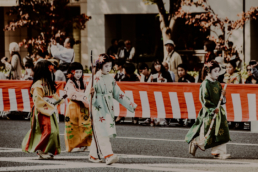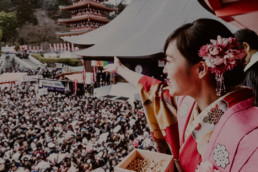Jidai Matsuri
The Jidai Matsuri ( 時代祭り, literally "The Festival of Historical Epochs"), celebrated in Kyoto on October 22 of each year. This festival represents a magnificent opportunity to experience over a thousand years of Japanese feudal history as direct spectators in a single day.
Jidai Matsuri, the Festival of Historical Epochs
Guest Author: Myriam
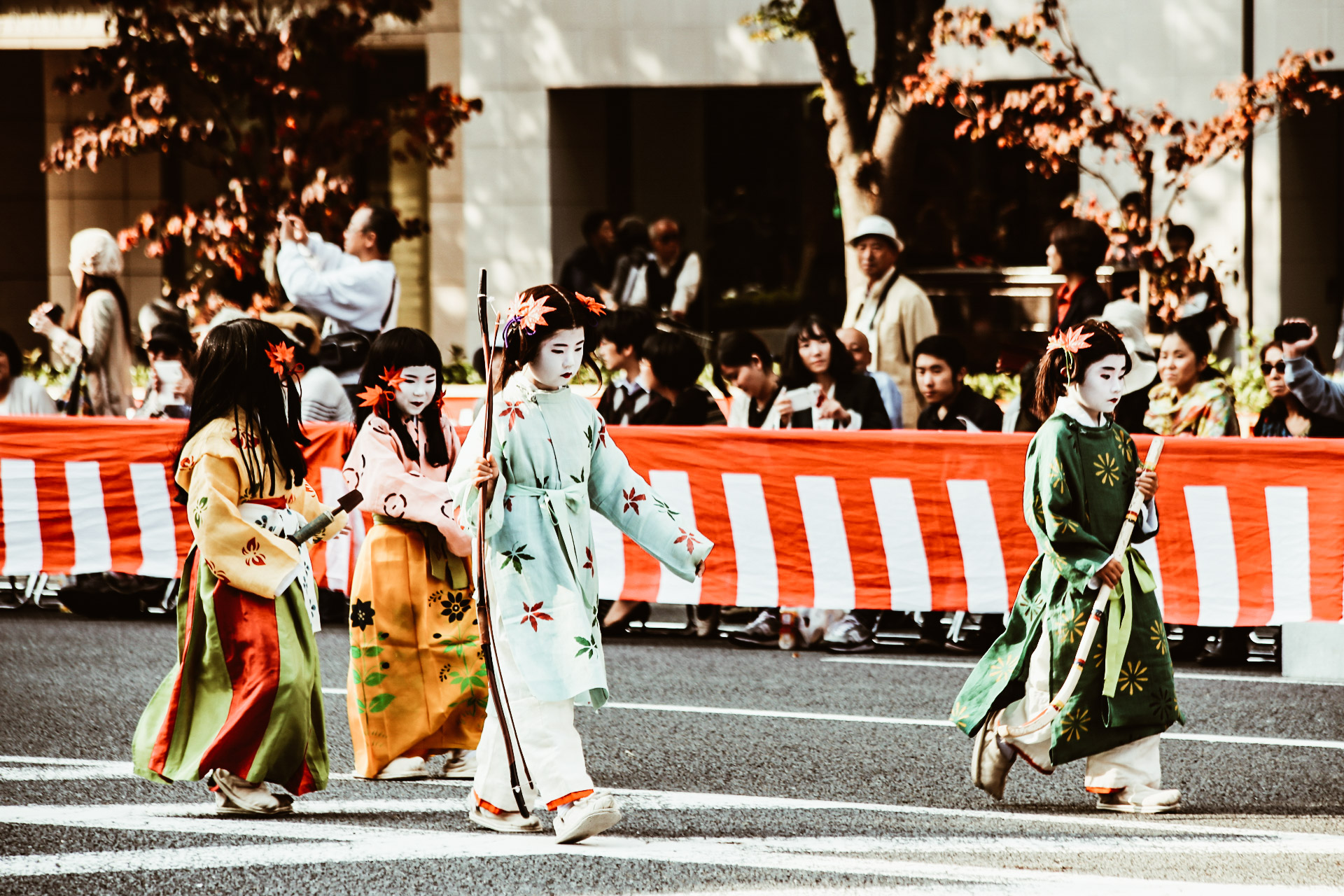
photo credits: travel-on.planet-muh.de
The origins
This festivity has its roots in the oldest history of Japan and recalls, through an impressive historical costume parade, the events and characters that have marked the life of the city since its foundation. It has been held since 794 by Emperor Kanmu (桓武天皇, Kanmu Tennō) until the transfer of the capital to Edo in 1868 by the decision of Emperor Mitsuhito.
Since its creation under the name of Heian Kyo (平安京, "capital of tranquillity and peace"), Kyoto has remained the capital of Japan almost uninterruptedly for over a thousand years. With the end of the Tokugawa Shogunate and the beginning of the Meiji Era, the entire imperial court was transferred to Edo, which became Tokyo (東京, literally "eastern capital").
In 1895 on the occasion of the 1100th anniversary of its foundation, the governments of the city and the prefecture of Kyoto established the Jidai Matsuri with the intention of restoring lustre to the ancient capital. Along with this, the aim was to honour the memory of the emperors Kanmu and Komei through the construction of the majestic Heian shrine.
A thousand years of history on the road
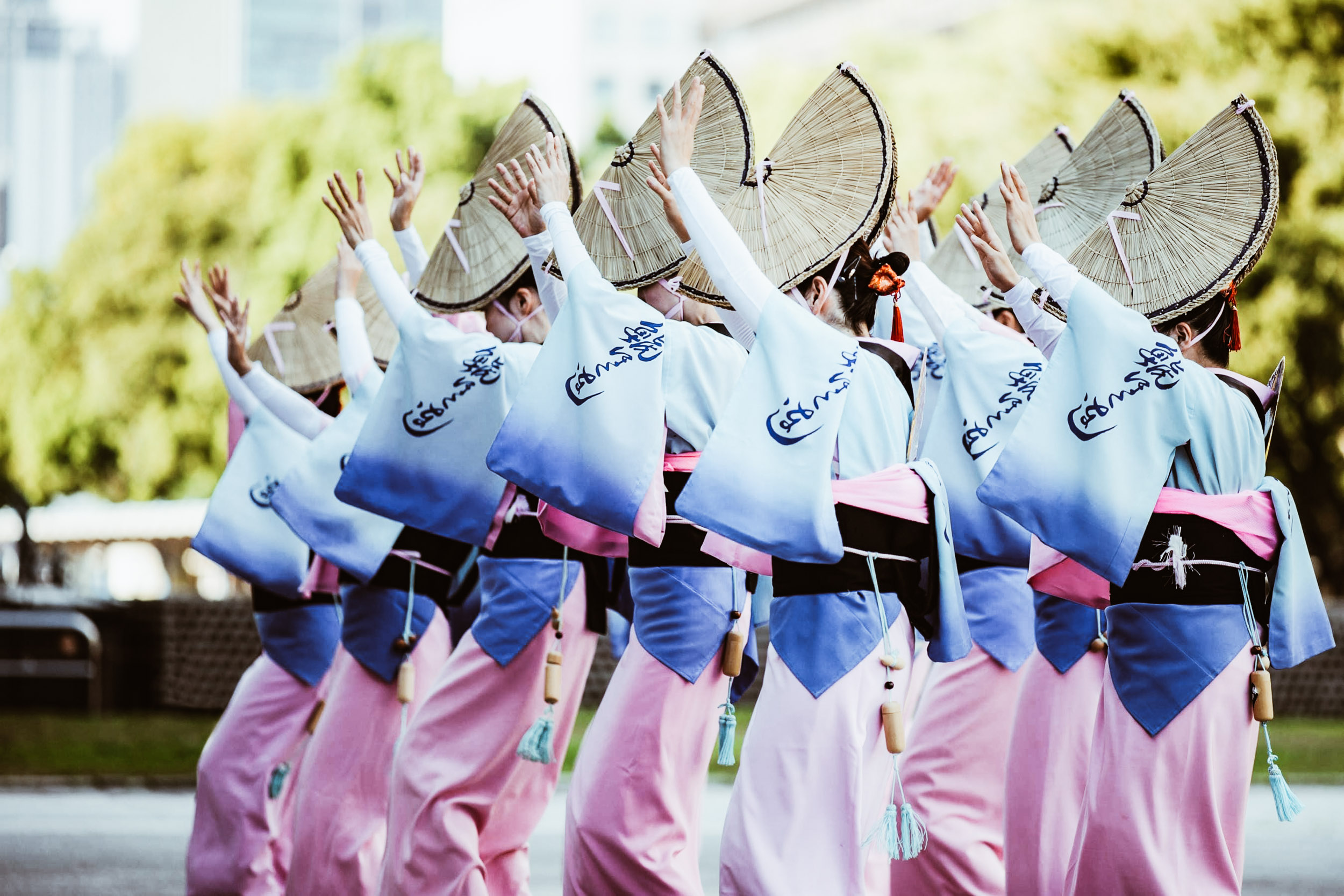
photo credits: fodors.com
Since then, on October 22 of each year, Jidai Matsuri brings back to life the splendour of feudal Japan. This allows residents and tourists to relive the life of the ancient capital for a few hours. Today, the main attraction of the festival is the Jidai Gyoretsu. It is a historical parade in which over two thousand participants take part, dressed in period costumes or in costumes meticulously reproduced by the craftsmen of Kyoto.
At the head of the parade are the mikoshi (portable sanctuaries) dedicated to the Kanmu and Komei emperors and the festival's honorary commissioners, on horse-drawn carriages in the style of the mid-19th century and from there the parade unfolds in reverse chronological order, from the Meiji Era to the Heian period, through about twenty thematic groups, which make it possible to rediscover, era after era, the characters who contributed to the history of the city, from simple peasants and soldiers to prestigious historical figures, such as the unifiers of the country Oda Nobunaga, Toyotomi Hideyoshi and Tokugawa Ieyasu, or figures of religious or cultural importance, such as Murasaki Shikibu, author of the famous "Genji Monogatari". The figures are accompanied by the music of drums and flutes, which together with the over 12,000 historical artefacts used, allow spectators to immerse themselves completely in the atmosphere of past eras.
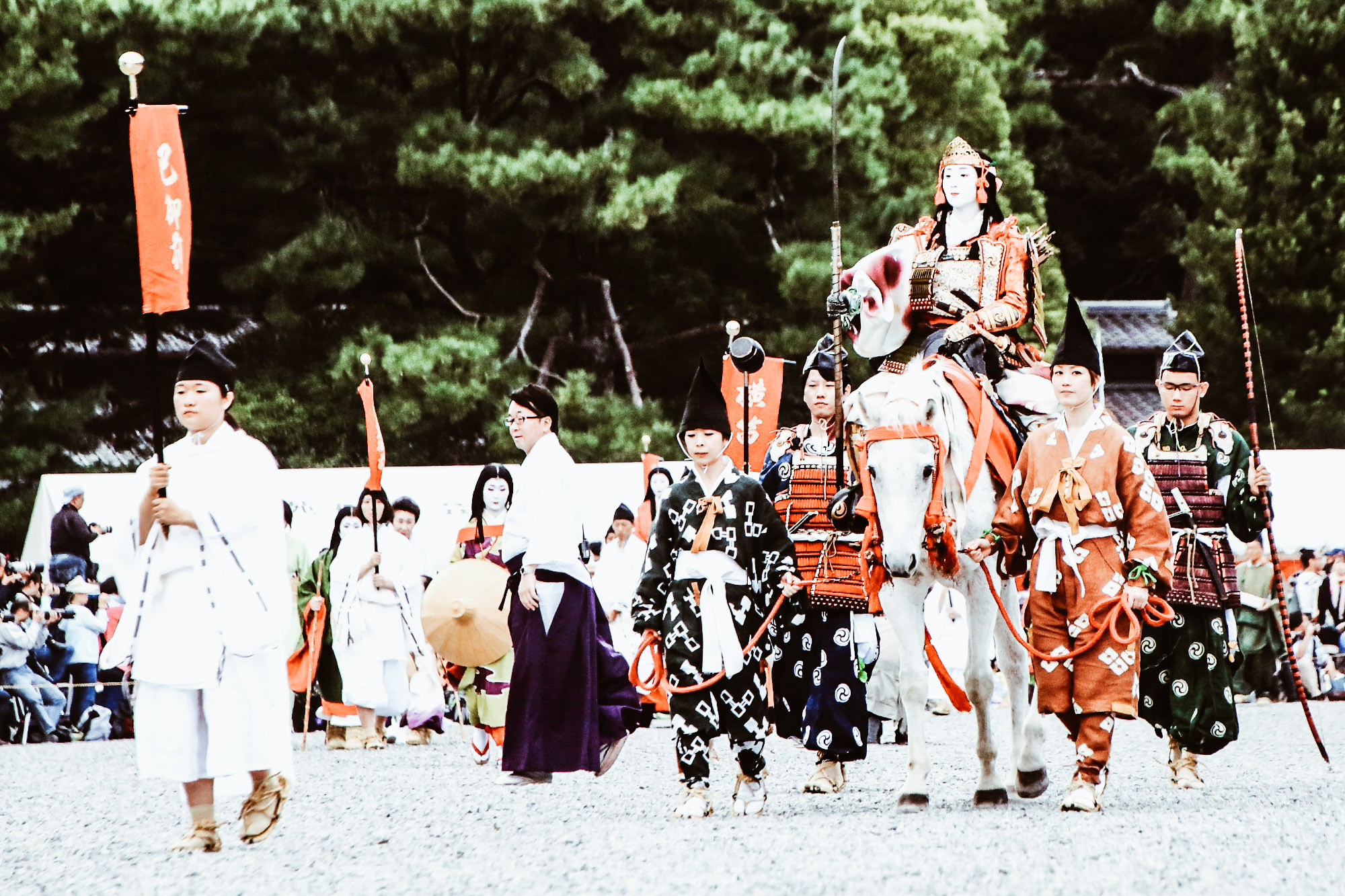
photo credits: blog.halal-navi.com
The long procession leaves at 12.00 noon from Kyoto Gosho, the imperial palace. It then winds for hours through the streets of the city centre, touching the most evocative and significant places. We see it passing by Oike and the Okazaki district, finally reaching the Heian Sanctuary. Here the Festival ends with the ceremonies foreseen by the Shinto rite.
Yuki-Onna: the mysterious incarnation of the Japanese winter
In the endless world of yokai (supernatural creatures of the Japanese tradition), the figure of Yuki-Onna (雪女) stands out. Legendary snow woman, with her icy and lethal charm, embodies the terrible beauty of winter in the mountains of Japan.
Despite being known by different names and stories in the various prefectures, this character is renowned above all in the coldest and most inaccessible areas of the archipelago.
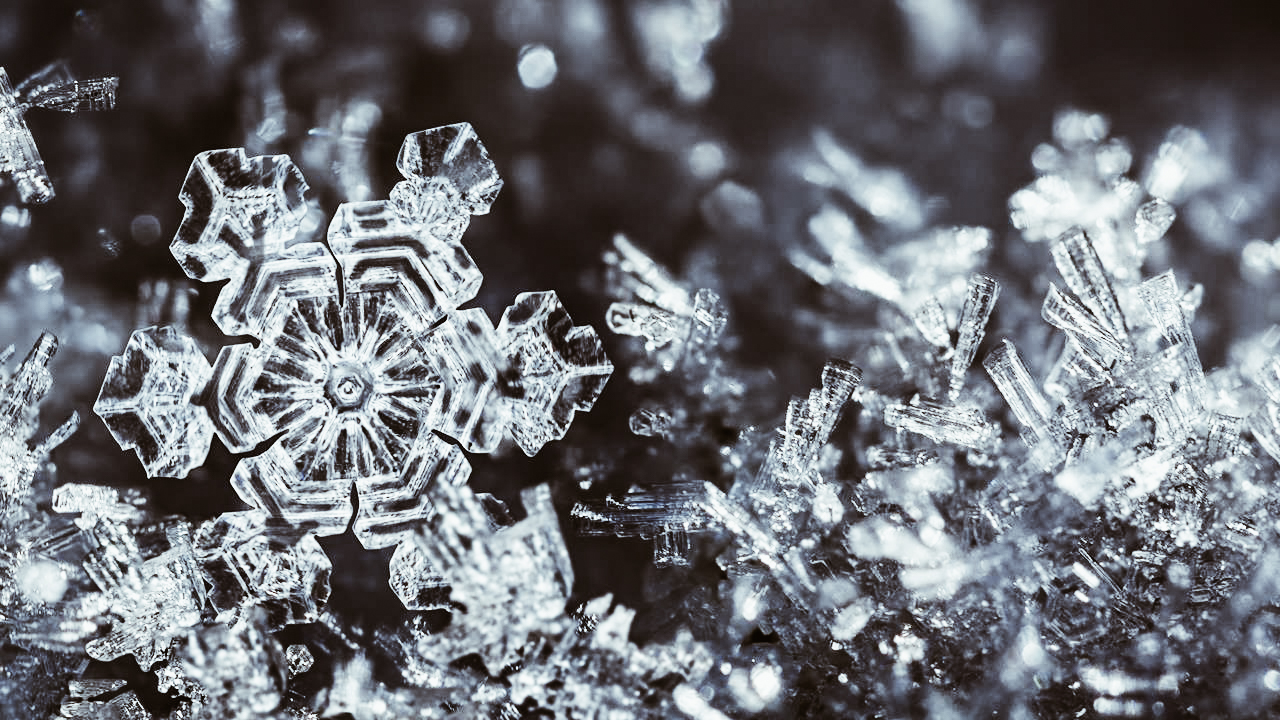
The Yuki-Onna is described as a beautiful woman with white skin, which appears on mountain trails and in snowstorms. She is dressed in a light white kimono or naked and covered only by very long hair, black or white depending on the legends. Ethereal and floating apparition in the snowy landscape on which it leaves no footprints, it can suddenly disappear turning into a cloud of fog or very fine snow.
Yuki-Onna: the Origins
The origin of this figure, like other yokai, is lost in the most ancient times. The first written trace of its history is found in the Sōgi Shokoku Monogatari, dating back to the Muromachi period (1333-1573). Here the monk Sogi describes the encounter with a woman of extraordinary beauty during his stay in the province of Echigo (current prefecture of Niigata). This mysterious woman was dressed in white, tall and with a very pale complexion and long white hair. From a young appearance, she mysteriously appeared one morning in the frozen garden of the monk. However, it disappeared just as mysteriously under the incredulous gaze of man.
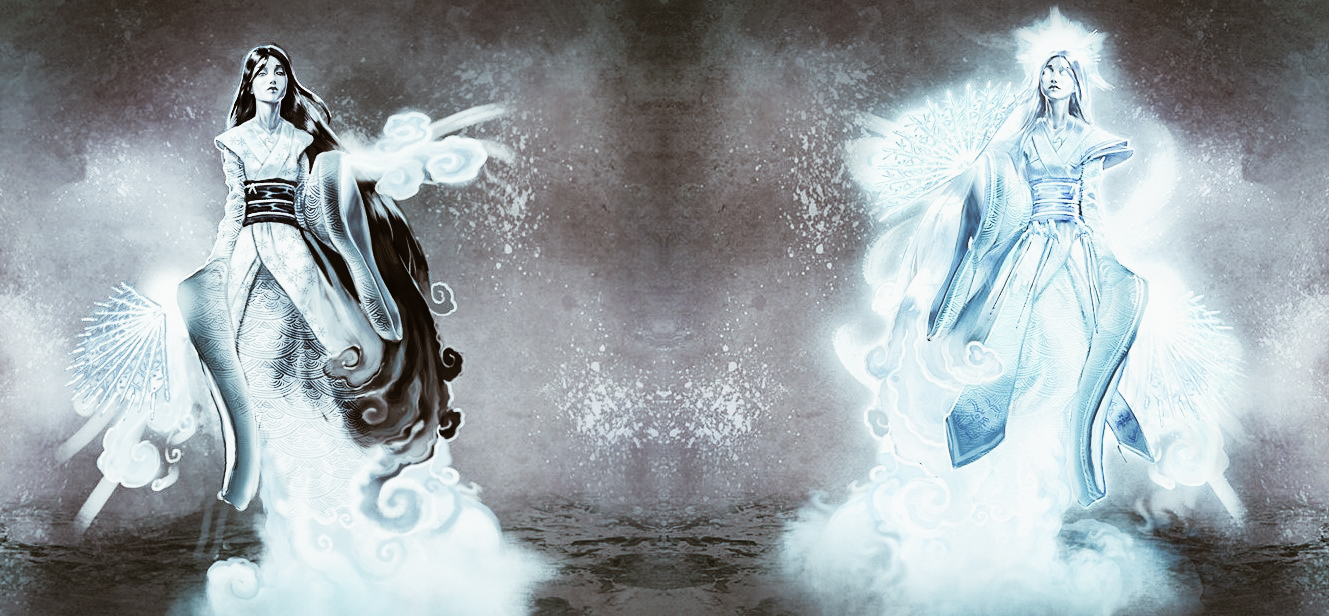
photo credits: smitefire.com
The two faces of winter
Like the winter that can manifest itself with a dazzling and serene splendor or with a cruel and lethal force, so is the Yuki-Onna. Sometimes it appears as a ruthless predator that attracts lost travelers into the storm to feed on them with their life energy. At other times it appears as a benevolent presence or even in its turn seduced by human charm.
In the most ancient stories, the monstrous and destructive aspect prevails. In fact, in these stories, parents who have lost their children in the mountains are approached by a woman. She asks them to pick up a child she can't bring herself. The unwary who accept this invitation are destined to freeze to death, overwhelmed by the fatigue of carrying a heavier burden at every step.
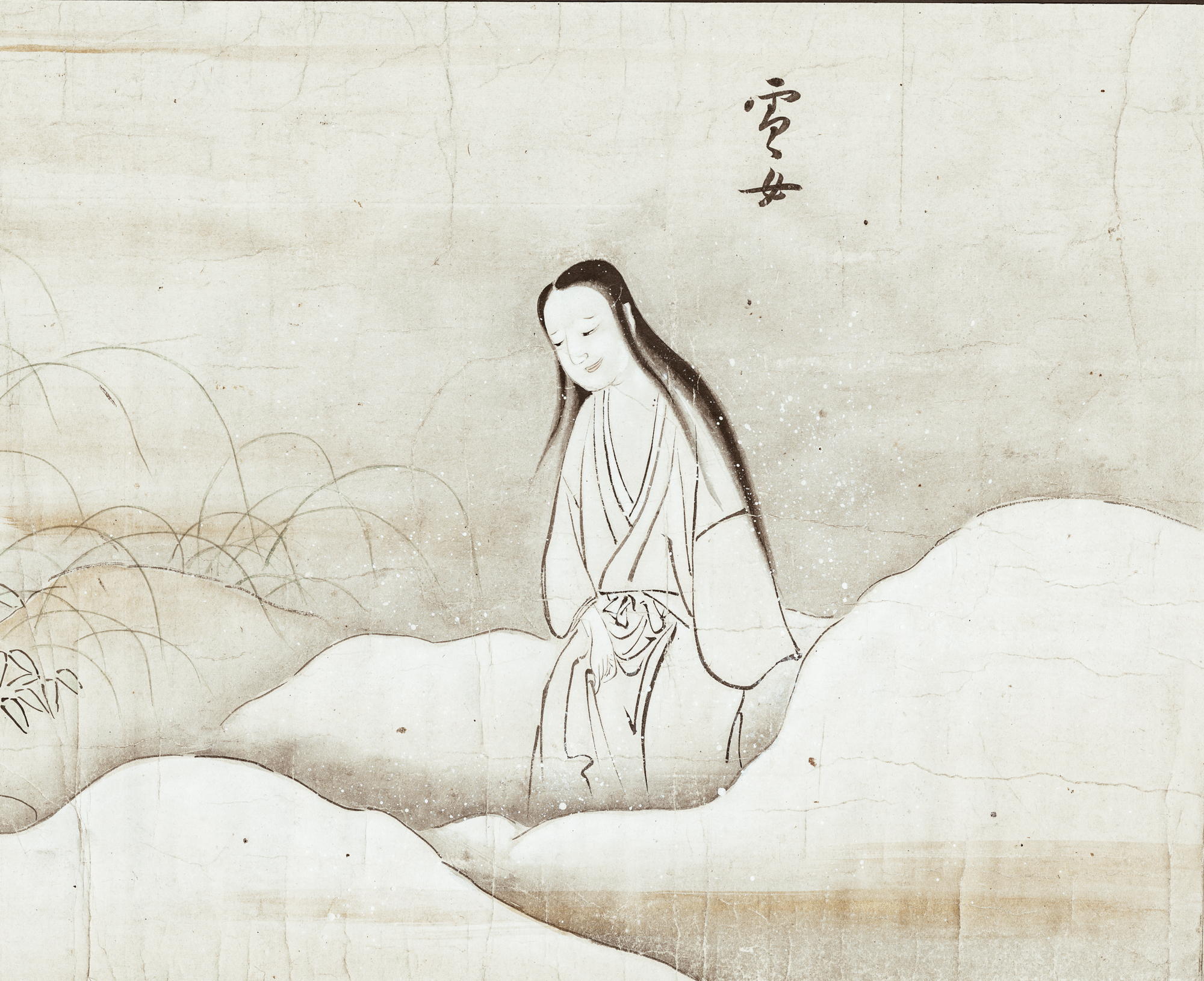
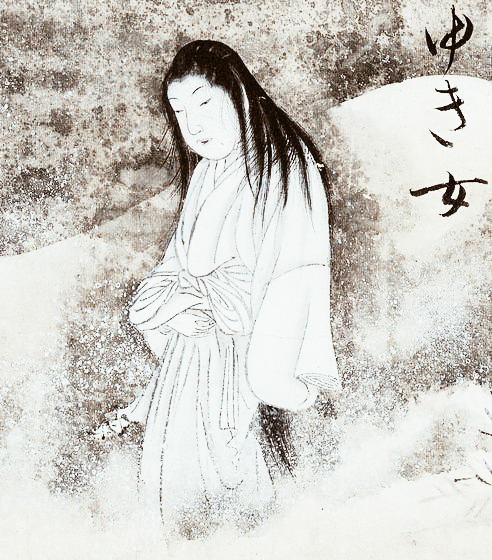
photo credits: wikipedia.org
Or in the stories, the Yuki-Onna seduces men subjugated by its otherworldly charm. They end up succumbing to his mortal kiss, able to drain their life force and freeze their hearts. Or again in dramatic stories, in which Yuki-Onna does not simply wait for the passage of bewildered travelers. Here, in fact, it enters the houses forcefully, opening doors and windows in the form of violent snowstorms, killing the unfortunate inhabitants.
In the West, we know a more romantic aspect of this reading. This is mostly thanks to the work of Patrick Lafcadio Hearn, a Ireland-born journalist and writer from Japan, also known as Koizumi Yakumo (小泉八雲).
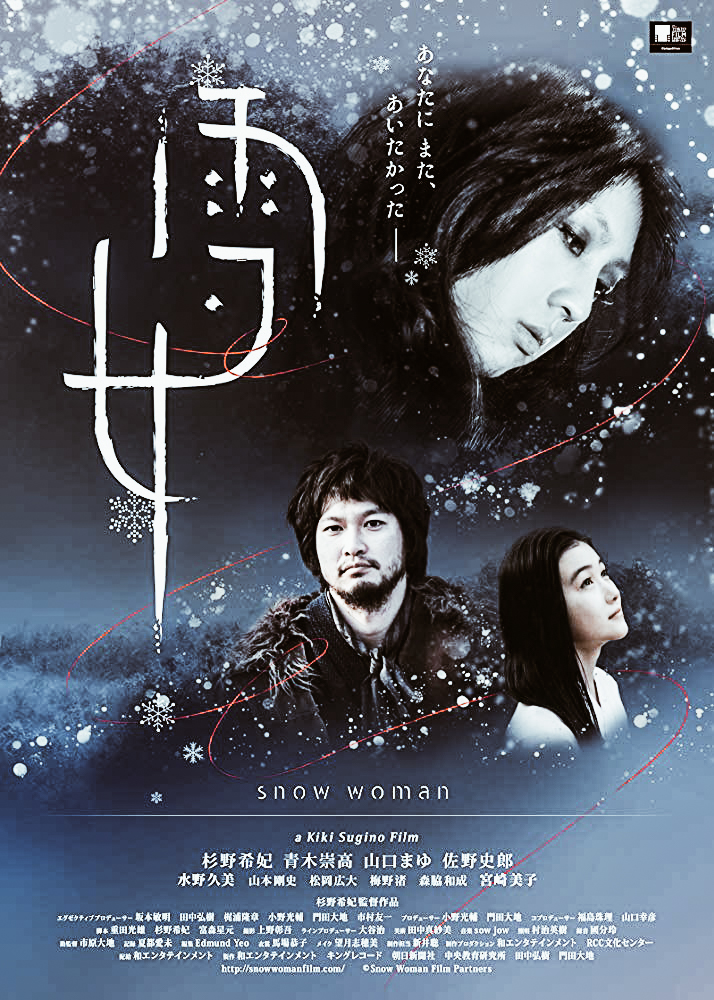
photo credits: letterboxd.com
The Lafcadio version
"Kwaidan: Stories and Studies of Strange Things" is a 1904 work containing a collection of popular beliefs and also an interpretation of the culture and customs of Japan. Here the legend narrated by Hearn speaks of two woodcutters, Elder Mosaku and his young apprentice Minokichi, who return home after a day's work on a cold evening. The two characters surprised by a violent snowstorm find shelter in a hut near a river. Afterward, the two men lay on the floor of the hut and, overcome by fatigue, they fall asleep. During the night Minokichi is awakened by an icy wind, which seems to have opened the door and windows of the hut. Still confused by sleep and believing he is dreaming, he sees a woman dressed in white and with long hair, bending over Mosaku, intent on breathing a cold mist like breath over him.
When the woman turns to Minokichi, the young man remains enchanted by her incredible beauty. However, he cannot sustain that look that inspires an unspeakable terror. Softened by the youth and the attractiveness of the boy, the woman decides to spare his life on condition that he never reveals to anyone the existence of such a creature. If he ever spoke to any of those events, his death would be certain.
The following morning a boatman, owner of the hut, finds in his interior the now frozen body of the elderly Mosaku, but manages to rescue Minokichi, now semi-frozen to safety.
A year later...
Having overcome the terror and exhaustion of that terrible night, the young man marries a beautiful young woman named O-Yuki. Suddenly appearing in his village she was immediately well-liked by everyone for her charm and her gentle manner. For many years the two live a happy marriage, blessed by the girl's inexplicable eternal youth, whose beauty seems to endure unchanged over time despite the birth of ten children.
Until one-day Minokichi, forgetting the promise he made, recklessly tells his wife of a supernatural creature he met many years before and that somehow seems to remind him of his charming bride. To his immense surprise, O-Yuki, suddenly transfigured by anger, reveals herself to be the woman he met that night. After having reproached her husband for not having been able to keep the promise of secrecy made so many years before, she decides to spare his life for the sake of their children. So, after warning him to take good care of them, she disappears forever.
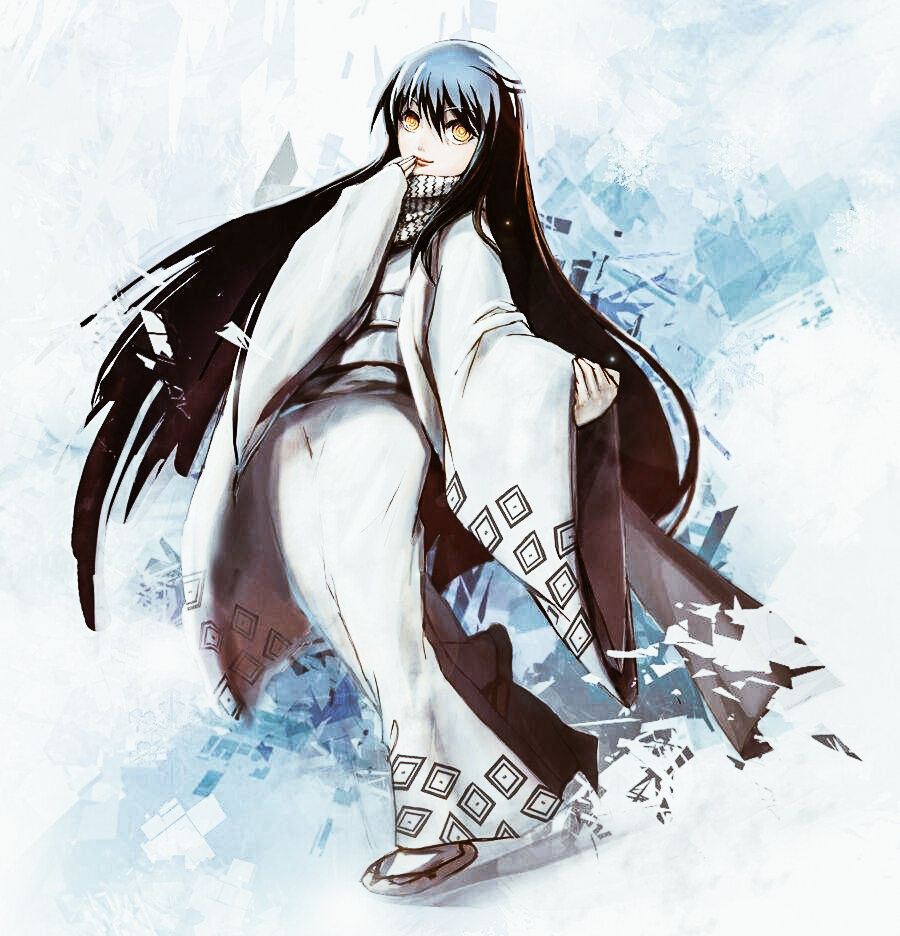
photo credits: aminoapps.com
Yuki-Onna in the contemporary age
Like the bride of Minokichi, the legend of Yuki-Onna, cruel and romantic at the same time, seems to preserve its charm over the centuries.
In fact, in contemporary times it has inspired numerous films. We remember in fact Kwaidan (怪怪) of 1965, directed by Masaki Kobayashi, winner of the special prize of the jury at the Cannes Festival. Kwaidan was also in the running for the Academy Awards with a nomination for Best Foreign Language Film.
The success of this film was followed, in 1968, by Kaidan Yukijoro by Tokuzô Tanaka, until 2016 with Yuki-Onna, directed and performed by Kiki Sugino.
The beautiful and lethal snow woman, in her innumerable variations, then appears as a protagonist or leading figure in a vast range of video games, anime and manga. Nurarihyon no Mago or Ranma ½, just to name a few. However, its timeless charm will continue to enchant us for a long time, with its eternal, candid winter.
Japan Folklore: Setsubun, how to drive away the demons of winter to welcome spring

photo credits: pinterest.it
Traditional Japanese culture has always been characterized by a constant and loving observation of the natural world, its manifestations and its seasonal cycles. Therefore, the attention given to spring, the special moment when nature awakens in all its creatures the necessity of renewal, must not marvel.
This season is celebrated in Japan with the haru matsuri (春祭, spring festival), a set of events whose beginning is marked by the occurrence of Setsubun (節 分). In the traditional Japanese lunisolar calendar, in fact, every change of season is introduced by a day called, indeed, setsubun (literally "division of the seasons"). Spring setsubun, which falls on 3 February, represents the last day of winter and the day before the start of the new season. It marks the transition from "Taikan" (大寒, big cold) to "Risshun" (立春, first day of spring) and is therefore the most favorable moment for a special "cleaning" from winter burdens, which will drive away evil spirits and favor the entrance of the new life-giving energy. This is the meaning of the traditional "demon expulsion" that takes place on this day through different rituals and customs.
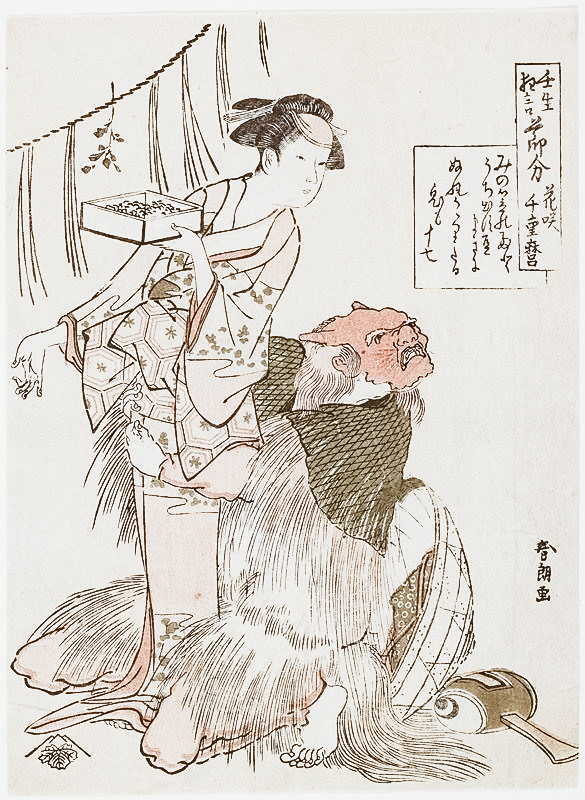
photo credits: pinimg.com
Ancient rituals and family fun
The most famous ritual is undoubtedly the mamemaki (豆 撒 き), which is the launch of soy beans. In the domestic sphere it is entrusted to Toshi Otoko (年 男, man of the year), that is the man of the family of the zodiacal sign of the lunar year entering or in his absence the oldest of the house. He has the task of driving out the harmful spirits and negativities from the house and the new year that is about to start by throwing around irimame (炒 り 豆, toasted soy beans) to the cry of "Oni wa soto! Fuku wa uchi! (鬼は外! 福は内, "Outside the demons! Inside fortune!"). In alternative, he can hurl the beans at another member of the family who plays the part of the demon wearing a mask of oni (Japanese folklore ogres). Subsequently, each member of the family must collect and eat a number of beans corresponding to their age plus one to ensure a year of success and good health (in the popular tradition, in fact, the demons are considered carriers of natural disasters and diseases).
When the oni is expelled, it is necessary to keep the evil spirits away from the house. For this reason it is possible to see in this period of the year some very special amulets, the Hiiragi Iwashi (柊 鰯), exposed at the entrance of the houses. These are holly branches that have the head of a dried sardine skewered on the end, sometimes complemented by pieces of garlic or onion, which have the purpose of keeping demons away, scared by the thorns and the pungent odor emanating from these talismans.
In both cases it is a tradition that has its roots in antiquity. Nowadays it is possible to buy "Setsubun sets" - made of oni masks and roasted beans - in any combini, but in reality the mamemaki custom would have originated in the Muromachi period (1392-1573) and seems to be inspired to an ancient legend, whose plot is still represented in the form of pantomime in the temple of Mibu-dera in Kyoto. Here the kyogen (ancient Japanese theatrical form) titled "Setsubun" is repeated several times during the day and it is said that it is sufficient to watch it to be purified by any negative or evil spirit. Its plot follows the folk tale that tells of an ogre who, in human form, goes one day to visit a widow. Thanks to its magic hammer, the ogre makes a beautiful kimono, which attracts the widow's attention. Eager to take possession not only of the kimono but also of the magic hammer, she decides to get him drunk to be able to steal them both. The ogre, however, aware of the theft, reveals his demonic nature and attacks the woman, who defends herself with the first thing that is within reach: a handful of soy beans. The oni, wounded but again in possession of his goods, flees leaving the widow safe and sound and perhaps a little wiser.

photo credits: toyokeizai.net
Knowing how to look in the right direction
A tradition of more recent origins, born in Osaka but later spread to the rest of the country, is instead linked to the ehōmaki (恵 方 巻, scroll of lucky direction). In this case, to ensure that the good luck is on our side in the year that is about to begin, it is necessary to eat a special sushi roll in a single solution, without interruptions and in silence, facing the lucky direction of the year. The act is less simple than it may seem, considering that the ehōmaki is much more often than a common sushi roll (having to contain seven ingredients to propitiate the seven gods of luck) and is 20 centimeters long. It is not worth eating it cut into pieces, because doing so would also cut luck. To perform the ritual correctly, it is therefore necessary to arm yourself with concentration, determination and a precise compass. For those interested in experimenting with this custom, the most common ingredients to obtain for the filling are cucumber, surimi, salmon, tuna, anago (sea eel), tamagoyaki (Japanese omelette), dried kanpyo strips and seasoned (Japanese pumpkin) and shiitake mushrooms, as well as rice and nori seaweed, while the lucky direction for 2019 is East-North East.
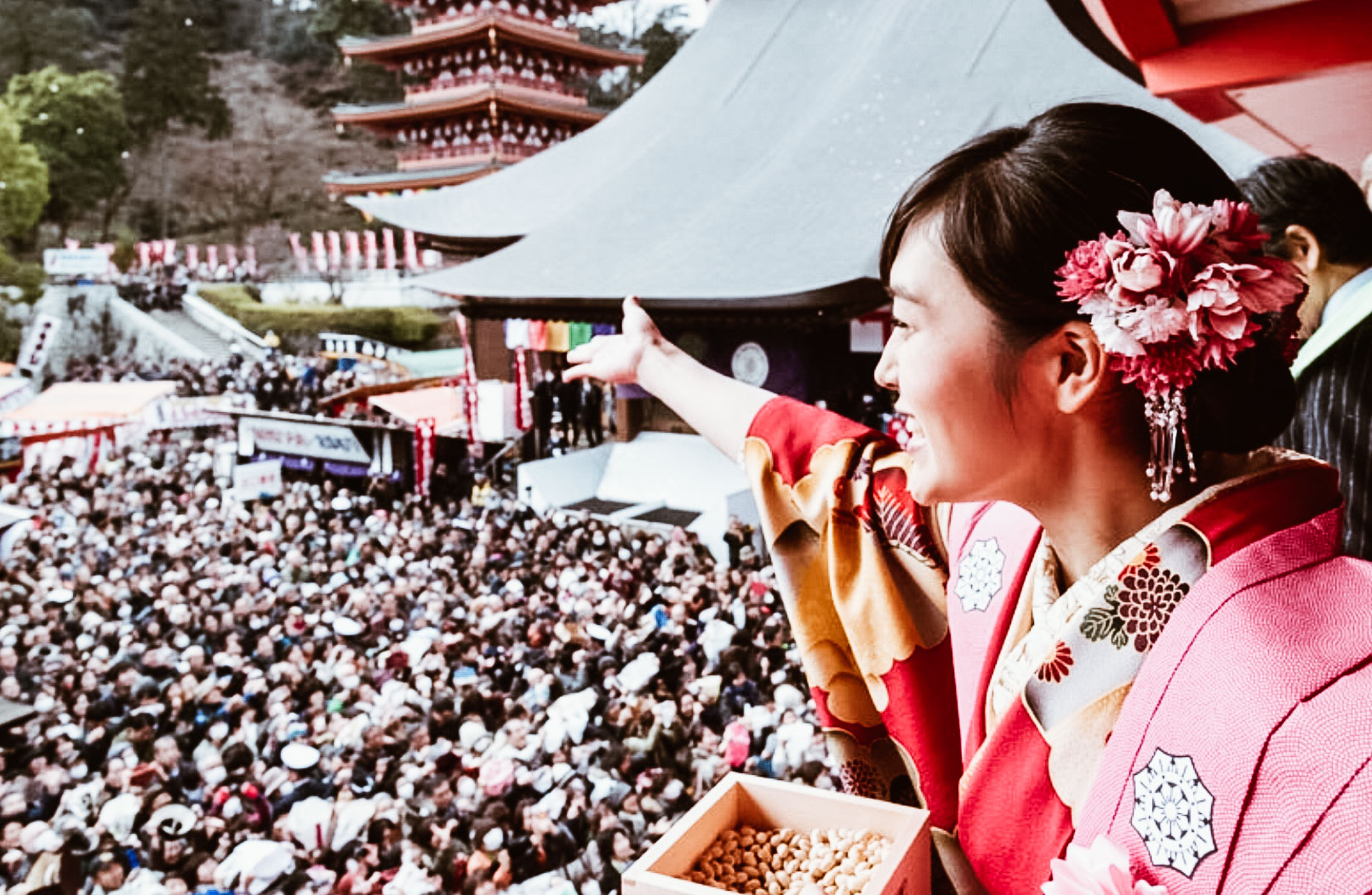
photo credits: shinsenhino.com
Festive temples
The Setsubun can be celebrated in a domestic environment or at least in a private dimension, with relatives and friends, but it is also and above all a recurrence to be lived in community. For example, schools often organize moments of recreation for children, who wear oni masks or have fun chasing adults dressed as demons while hurling beans against them. But it is especially in the temples that it is possible to experience the collective dimension of the party, participating in the events specially created for this day. First of all, of course, the mamemaki, carried out by the monks who throw soy beans from the top of the stages on the crowd gathered for the event. In some temples more shifts are organized for this ritual, reserving some special ones for children, who in addition to the beans receive sweets or small gifts. In addition to the monks, celebrities are often present, such as sports champions, personalities of the entertainment world, actors of the kabuki theater, geisha and maiko, television celebrities, who add a note of attractive glamor to traditional festivities. Among the latter we must remember the theatrical performances, the various purification ceremonies or even the striking archery performances, in which the archers throw their arrows at targets that have demon-like features.
In short, Setsubun is the ideal day for those who wish to live in company a start of the year that helps to renew their energies and for families who have the opportunity to spend a moment of joy together, something that always remains the best talisman against all evil at every latitude.







